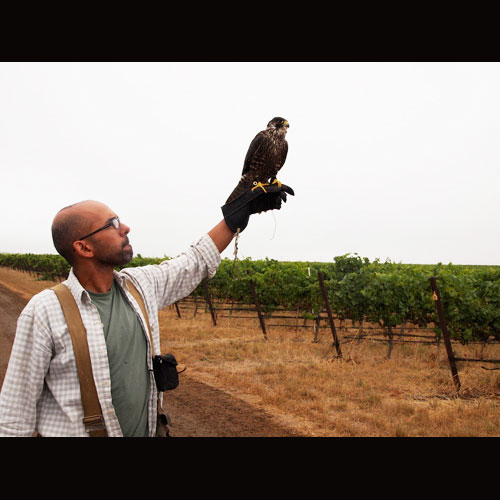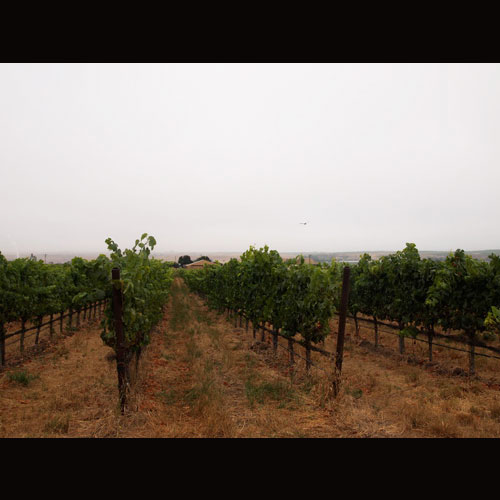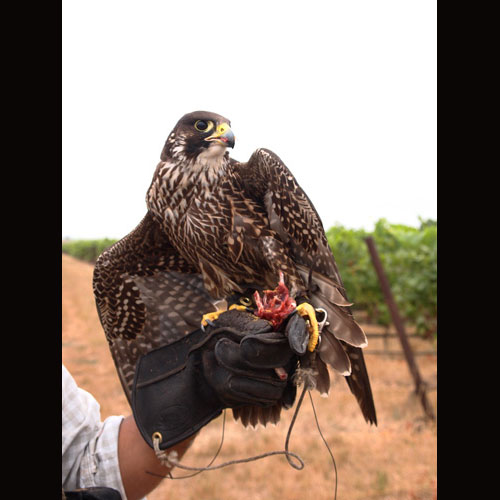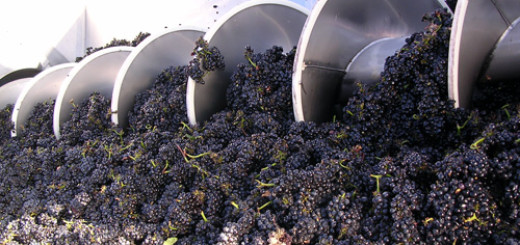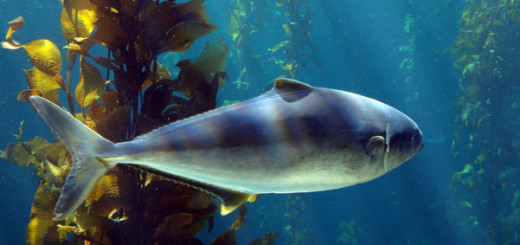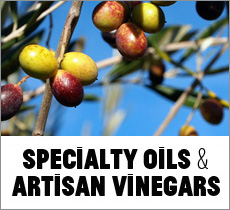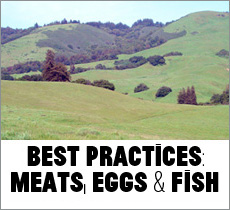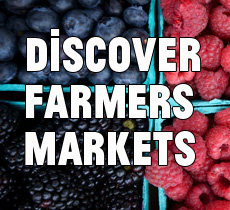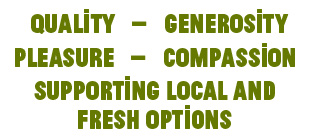Friends of the Vineyard at Bien Nacido
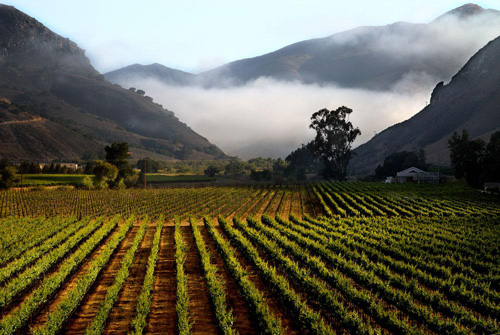
looking north toward North Canyon (photo: Adam Felde)
From crime-fighting falcons to weed-eating goats to bug-busting swallows, Bien Nacido Vineyards has many friends who help produce quality grapes for award-winning wines in this sweet spot vineyard. Located in the Santa Maria Valley AVA of northern Santa Barbara County, Bien Nacido’s vineyards are exposed to maritime influences that directly cool the area through the east/west orientation of the valley as are their sister vineyards to the southwest, Solomon Hills. These vineyards host a wide variety of soils, elevations, clones, and rootstocks, with each producing beautifully distinct wines. Providing powerful assistance to the stewards of these special vineyards are Boer Goats, Barbados/American Black Belly Sheep, and cliff swallows who live at the vineyards full time while other vineyard friends such as Peregrine Falcons visit the vineyards regularly but itinerantly. [Scroll for slideshow]
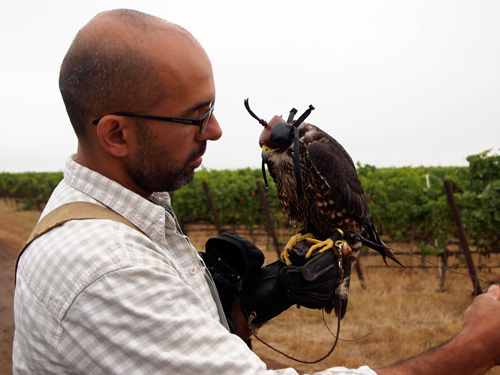
Vahe’ explains equipment used for tracking
On a foggy midsummer morning tour of Bien Nacido Vineyards, I had a chance to meet Shaman, a 1 year-old Peregrin Falcon still sporting the brown feathers of a juvenile before growing into his grays. Vineyard manager and vineyard tour guide Chris Hammell had suggested we take a few minutes to observe Master Falconer Vahe’ Alaverdian of Falcon Force Bird Abatement working with one of his nine falcons in a nearby vineyard block. Demonstrated hunting behavior in an area by Falcon Force staff helps protect these vineyards and other fruit crops throughout California and the Pacific Northwest as fruit begins to ripen and attract nuisance bird attention. Scaring starlings, blackbirds, and other nuisance birds with 15-45 minutes of falcon hunting behavior every day discourages hungry birds far more effectively than nets, poison, inanimate mylar ribbons frenetically blowing in the wind, or automatic intermittent cannon booms.

Falcon Force uses the natural predator/prey relationship to discourage birds from feeding in a vineyard block or orchard by instilling in them the fear that they might risk attack by a powerful bird who clearly enjoys hunting this territory. Each falcon flies 2-6 times a day over every corner of the vineyard. “It’s the most effective way of protecting ripening fruit,” says Vahe’, a point reinforced later that morning when we spoke with another Santa Maria Valley winemaker who moaned about how picked over his blocks of Pinot Noir were at this point in August, having decided to forgo the cost of falcon protection this year. The falcons make a marked difference when it comes to getting the most perfect and least damaged harvest out of a vineyard and, when you’re buying “well born” grapes from an ultra-premium site like Bien Nacido, every last berry matters.
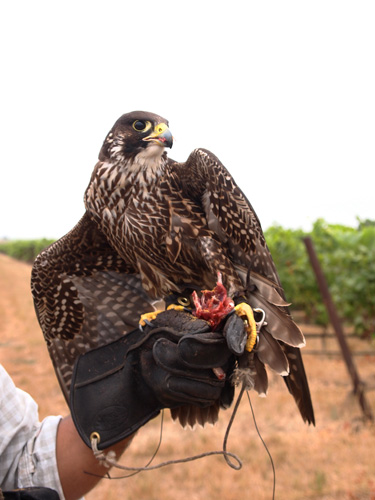
eating starlings for breakfast
As Vahe’ removed the falcon’s hood, Shaman’s sharp eyes immediately began to search the skies for activity. Responding to voice signals, he took flight and made a circuit of the vineyard to watch for other birds (we didn’t see any while we were there) as well as the falconer. Vahe’ began to swing a lure made of a tennis ball, a starling’s wing, and a length of cord that allowed him to make the target fly fast enough to be hunted by a Peregrine. Read: Very Fast. Practice hunting with the lure helps refine the skills of this young, captive-bred falcon as well as sends a message to nuisance birds that falcons frequent this vineyard for hunting, so best stay away. Despite a jingling bell and telemetry wire on his leg to facilitate tracking, Shaman executed every command perfectly and richly deserved his reward of raw flesh, which his beak and claws completely destroyed with dispatch. Amazing.
Featuring Bien Nacido Fruit
The Miller Family bought this land in 1969 and moved quickly to realize the full potential of the property by planting hundreds of acres of wine grapes. The Millers, Chris Hammell, and the Bien Nacido team steward these 750 acres of vineyards thoughtfully and offer best practices in vineyard management such as natural bird abatement to their customers which include Longoria, Sanguis, and Au Bon Climat among others. They manage 250 acres of vines for premium vineyard-designate wines.
Bien Nacido makes extra efforts in the vineyard because they believe that careful management employing organic, biodynamic, and sustainable best practices helps produce quality fruit to serve as the foundation for ultra premium Central Coast wines. For years, many wineries have sourced fruit from vineyards owned and managed by the Miller family and their team who remain committed to producing the best fruit possible on these diverse properties.
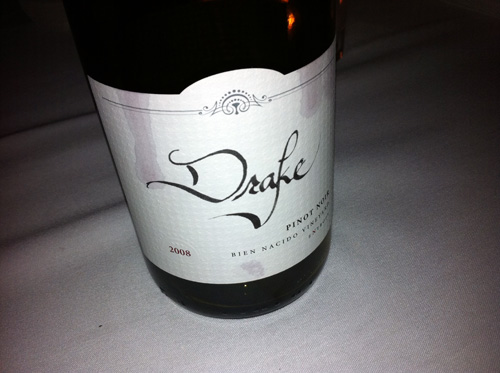
Drake at the Big Sur Food & Wine party
Good fruit matched to talented winemaking produces memorable wines, so we’re now keeping our eyes open for these vineyard-designate wines at tastings such as World of Pinot Noir and the Pebble Beach Food and Wine Festival. I know that Kenneth Volk Vineyards has sourced grapes from all three vineyards owned and managed by the Millers including French Camp Vineyards in the Paso Robles AVA. At the 2011 Big Sur Food and Wine Festival, we enjoyed two Drake Pinot Noirs featuring Bien Nacido fruit poured for us by winemaker Mark Cummins. “You’ve got to start with great fruit,” agrees Mark, reinforcing what every good winemaker knows: the best wines begin in the vineyard. To me, Drake’s delicious Pinots seemed impressive and restrained at the same time: unmistakable California sunshine in the fruit and Burgundy in the winemaking.
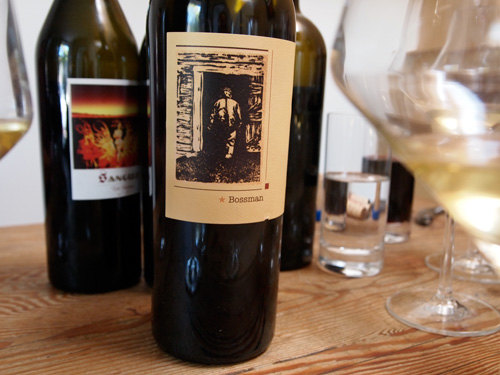
Bossman by Sanguis in the Funk Zone
In August, we also had a chance to taste through the Sanguis portfolio of wines in their Santa Barbara wine space including a wine called “Bossman.” Winemaker Matthias Pippig used Bien Nacido Syrah to provide 99% of the spine, personality and attitude of the Bossman, with 1% Viognier added like a kiss on the cheek. This powerful single varietal bottling was a match to the artistic blends Matthias had quietly but proudly shared with us. We will enjoy searching for Bien Nacido fruit as we taste wines this year and in the festivals to come.
A Window for the Vineyard
Regardless of who made the wine you enjoy produced with Bien Nacido grapes—whether Ken, Mark, Matthais, or dozens of other notable California winemakers—it all started here with bench land vineyards on either side of the Cuyama River and in the hills of what becomes North Canyon, to the north. A comprehensive approach to sustainable vineyard management practices reflects the fact that grapes grow in ecosystems containing a diverse range of organisms. By planting acres of citrus and avocados, Chris and the vineyard team ensure a healthy diversity of organisms that support the vineyards by preventing them from becoming a monoculture. The swallows appreciate the habitat created with 70 acres of avocado trees and new plantings of Meyer lemon trees; in return, they eat insect pests that can transmit disease to a vine.

Boer goats and Barbados/American Black Belly sheep graze near the vineyards and Cuyama River
“Everything you do has repercussions,” muses Chris as he describes some of the unexpected consequences that stem from discrete vineyard management choices. One of their most important choices as a company and a family was to pursue SIP Certification: “It’s the gold standard. SIP is the most important certification for a vineyard,” says Chris. They’re also pursuing Demeter biodynamic certification, California Certified Organic Farmers (CCOF) certification, and California Association of Winegrape Growers (CAWG) certification. As challenging as grape growing can be, especially in recent years with increasingly erratic weather patterns, Bien Nacido Vineyards remains committed to growing wine grapes well using sustainable practices.
To honor the great efforts made in these vineyards, winemaker Trey Fletcher produces 100% varietal wines providing, as Nicholas Miller puts it, “a window for the vineyard.” With the flexibility they have to sell grapes as growers as well as reserve some fruit for their own private labels, they work hard to “make it exactly what it is, every year.”
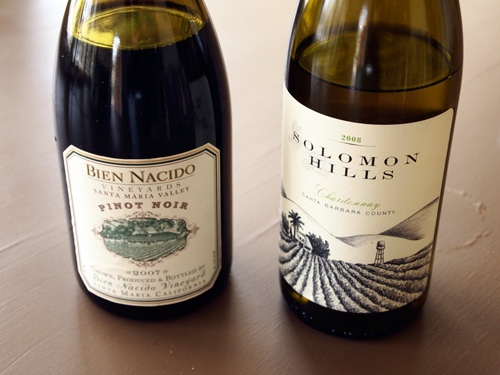
limited production wines from Bien Nacido and Solomon Hills vineyards
What’s even more perfect than producing 400 cases of grower’s reserve wines from some of the Central Coast’s premiere vineyards? These vines are own-rooted rather than grafted onto phylloxera-resistant North American rootstock, making them arguably more “themselves” as varietals than grafted vines. Solomon Hills Vineyards feature very sandy soils while Bien Nacido vines grow in shale and dolomitic limestone; both soil types resist phylloxera and allow vines to grow on their own “French feet.”
Nothing signals that the Central Coast deserves its place among other world-class wine regions more than the loyalty and passion great winemakers have for the fruit produced in these exceptional vineyards. Truly passionate winemakers like Paul Lato and Ken Volk consider themselves fortunate to have access to Bien Nacido’s highest quality fruit because quality fruit rewards thoughtful winemaking with truly exceptional, memorable wines.


